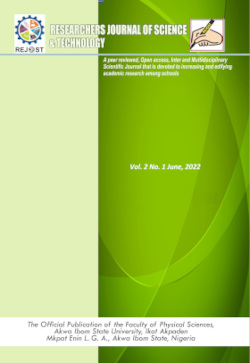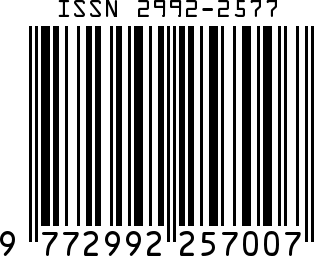Application of pollution indices in estimating the toxicity of heavy metals in sediments of Okoro River in Eastern Obolo, Southeastern Nigeria
Keywords:
sediments, heavy metals, enrichment factor (EF), geo-accumulation index (Igeo), contamination factor (CF), pollution load index (PLI)Abstract
The sediments of Okoro River were studied to assess the contamination status of the heavy metals present. Particle induced X-ray emission (PIXE) technique employed revealed the present of Ti, Cr, Mn, Fe, Cu, Zn, Rb, Sr, Zr, and Pb. The results revealed that the concentrations ranged from 1942.2-6299.3 mg/kg for Ti, 55.5 - 171.7 mg/kg for Cr, 71.7 to 374.2 mg/kg for Mn, 6881.5 - 66477.0 mg/kg for Fe, 5.9 - 37.6 mg/kg for Cu, 8.6 - 84.5 mg/kg for Zn, 0.0 - 226.4 mg/kg for Rb, 0.0 - 107.0 mg/kg for Sr, 59.7 - 1333.2 for Zr and 0.0 -51.7 mg/kg for Pb. Pollution indices such as enrichment factor (EF), geoaccumulation index (Igeo), contamination factor (CF) and pollution load index (PLI) were employed to assess the levels of pollution of the sediments of the River. The results revealed that the sediments were polluted with the present of these heavy metals detected as confirmed from the mean value of PLI greater than 1 (i.e. mean value of PLI = 1.13). This pollution is as a result of external influences on the River. The concentrations were also subjected to multivariate statistical analysis such as Pearson correlation coefficient and cluster analysis, which revealed only positive coefficient of some heavy metals and that, signified artificial similar sources of the heavy metals to the aquatic bodies in the river.
References
Abbas, F., Norli, I.A., Aness, A., Azharmat, E., 2009. Analysis of Heavy Metal Concentrations in Sediments of Selected Estuaries of Malaysia- A Statistical Assessment. Environ. Monit. Assess. 153, (1-4), 179-185.
Abrahim, G.M.S. Parker, R. J., 2007. Assessment of heavy metal enrichment factors and the degree of contamination in marine sediments from Tamaki Estuary, Auckland, New Zealand. Environ Monit Assess. 136, 227–238.
Abdullah, M.Z., Manap, N. R.A., Saat, A., Hamzah, Z., Abas, M.T., 2015. Evaluation of heavy metal contamination levels of balok River Sediments in Pahang, Malaysia based on geoaccumulation index and supported with enrichment factor. Malaysian J. Analytical Sci. 19 (4), 07-
Addo, M.A, Affum, H.A., Botwe, B.O., Gbadago, J.K., Acquah, S.A., Senu, J.K., Adom,T., Coleman, A., Adu, P.S., Mumuni, I.I., 2012. Assessment of water quality and heavy metal levels in water and bottom sediment samples from Mokw Lagoon, Accra Ghana, Research J. of Environ. and Earth Sc.4(2): 119-130.
Adeniyi, A. A, Owoade, O. J.,Shotonwa, I. O., Okedeyi, O. O., Ajibade, A.A., Sallu, A.R., Olawore, M.A. and Ope, K. A., 2011. Monitoring metals pollution using water and sediments collected from Ebute Ogbo River Catchments, Ojo, Lagos, Nigeria
Ahdy, H. H. H., Khaled, A., 2009. Heavy metals contamination in sediments of the Ajao, Western Part of Egyptian Mediterranean Sea. Australian J. B. App. Sc. 3(4): 3330-3336.
Akpan, I. O., Thompson, E. A., 2013. Assessment of heavy metal contamination of sediments along the Cross River Channel in Cross River State, Nigeria. J. Environ. Sc. 2(5): 20-28.
Atkinson, C., Jolley, D., Simpson, S., 2007. Effect of overlying water pH, dissolved oxygen, salinity and sediment disturbances on metal release and sequestration from metal contaminated marine sediments,” Chemosphere, 69(9), 1428-1437.
Bai, J.H., Cui, B.S., Chen, B., Zhang, K.J.,Deng, W., Gao, H.F., Xiao, R., 2011. Spatial distribution and ecological risk assessment of heavy metals in surface sediments from a typical plateau lake wetland, China, Ecological Modeling, 222, 301-306.
Banerjee, S., Pramanik, A., Sengupta, S., Chattopadhyay, D., Bhattacharyya, M., 2017. Distribution and source identification of heavy metal concentration in Chilika Lake, Odisha India: an assessment over salinity gradient. Current Sci. 112, 1.
Barakat, A., El Baghdadi, M., Rais, J., Nadem, S., 2012. Assessment of heavy metals in surface sediments of Day River at BeniMellal Region, Morocco. Res. J. Environ. Earth Sc. 4(8): 797- 806.
Begum, B. A., Biswas, S. K., Hopke, P. K., Cohen, D. D., 2006. Multi- element analysis and characterization of atmospheric particulate pollution in Dhaka, Aerosol and Air Quality Res. 6, 4: 334-359.
Bentum, J. K., Anang, M., Boadu, K. O., Koranteng-Addo, E. J., Antwi, E. O., 2011. Assessment of heavy metals pollution of sediments from Fosu Lagoon in Ghana. Bull. Chem. Soc. Ethiop. 25(2), 191 – 196.
Bettinentti, R., Giarei, C. and Provini, A., 2012. A Chemical Analysis and Sediment Toxicity Bioassays to Assess the Contamination of River Lambro (Northern Italy). Archives Environ. Contam. Toxi. 45 (1), 72.
Brunner, I., Luster, J., Günthardt-Goerg, M., Frey, B., 2008. Heavy Metal Accumulationand Phytostabilisation Potential of Tree Fine Roots in a Contamination Soil, Envron Pollut, 152(3), 559- 568.
Campbell, L. M., 2001. Mercury in Lake Victoria (East Africa): Another emerging issue for a Beleaguered Lake? Ph.D. dissertation, Waterloo, Ontario, Canada.
Chakravarty, M., Patgiri, A., 2009. Metal Pollution Assessments of the Dikrong River, N.E. India. J. Human Ecol. 27 (1), 63-67.
Demirbas, A., Pehlivan, E., Gode, F., Altun, T., Arslan, G., 2005. Adsorption of Cu (II), Zn(II), Ni (II), Pb(II), and Cd (II) from Aqueous Solution on Amberlite IR-120 Synthesis Resin. J. Colloid and Interface. Sci. 282: 20-25.
Department of Water Affairs and Forestry (DWAF), 1996b. Water Quality Guideline for Domestic Use. 2nd Edn., DWAF, Pretoria, 1.
El Diwani, G., El Rafie, Sh., 2008. Modification of thermal and oxidative properties biodiesel produced from vegetable oils. Int. J. Environ. Sci. Tech., 5 (3), 391-400.
Fatoki, O.S., Mathabatha, S., 2010. An assessment of heavy metal pollution in the East London and Port Elizabeth harbours. Water S.A., 27, 233-240.
Forstner, U., Wittmann, G. T. W., 1983. Metal Pollution in the Aquatic Environment.Springer-Verlag, Berlin, Heidelberg, New York, Tokyo.
Hakanson, L.,1980. Ecological risk index for aquatic pollution control, a sedimentological approach. Water Res. 14, 975–1001.
Harikumar, P., Jisha, T., 2010. Distribution Pattern of Trace Metal Pollutants in theSediments of an Urban Wetland in the Southwest Coast of India.Int. J. Eng. Sci.Tech., 2(5), 840-850.
Herut, B., Sandler, A., 2006. Normalization Methods for Pollutants in Marine Sediments. A Review and Recommendations for the
Mediterranean. IOLR Report. H 18.
Hu, D., He, J., Lu, C., Ren, L., Fan, Q., Wang, J., Xie, Z., 2013. Distribution characteristics and potential ecological risk assessment of heavy metals (Cu, Pb, Zn, Cd) in water and sediments from Lake Dalinouer, China. Eco. Environ. Safety, 93, 135-144.
Idrees, F. A., 2009. Assessment of trace metal distribution and contamination in surface soils of Amman. Jordan J. Chem., 4 (1), 77-87.
Idris, A., Eltayeb, M. A. H., Potgieter-Vermaak, S., Van Grieken, R., Potgieter, J. 2007. Assessment of Heavy Metals Pollution in Sudanese Harbors along the Red Sea Coast.Microchemical J. 87(2), 104-112.
IAEA-International Atomic Energy Agency (2003). Collection and Preparation of Bottom Sediment Samples for Analysis of Radionuclides and Trace Elements, IAEATECDOC-1360
Kontas, A., 2008. Trace Metals (Cu, Mn, Ni, Zn, Fe) Contamination in Marine Sediment and Zooplankton Samples from Izmir Bay (Aegean Sea, Turkey). Water Air Soil Pollution, 188: 323-333.
Linnik, P.M., Zubenko, I. B., 2000. Role of bottom sediments in the secondary pollution of aquatic environments by heavy metal compounds, lakes and reservoirs. Res. Manage., 5(1), 11-21.
Loska, K., Wiechula, D., 2003. Application of Principal Component Analysis for the Estimation of Source Heavy Metal Contamination in Surface Sediments from Rybnik Reservoir. Chemosphere 51, 723-733.
Lwanga, M. S., Kansiime, F., Denny, P., Scullion, J., 2003. Heavy metals in Lake George, Uganda with relation to metal concentrations in tissues of common fish specie. Hydrobiologia, 499 (1-3), 83-93.
Mhamdi, A.A., Choura, M., Maanan, M., Zourarah, B., Robin, M., 2010. Metal fluxes to the Sediments of the Moulay Bousselham lagoon, Morroco. Environ. Earth Sci. 61: 275-286.
Mmolawa, K., Likuku, A., Gaboutloeloe, G., 2011. Assessment of Heavy Metal Pollution in Soils along Roadside Areas inBotswana, African J. Environ. Sci. Tech. 5, (3), 186- 196.
Morin, S., Duong, T., Danbrin, A., Coynel, A., Herlory, O., Baudrimont,, M., 2008. Long Term Survey of Heavy Metal Pollution, Biofilm Contamination and Diatom Community Structure in the Rio Mort Watershed, South West France. Environ. Pollut. 151, 532-542.
Müller, G., 1969. Index of geoaccumulation in the sediments of the Rhine River. Geojournal, 2, 108–118.
Obiajunwa, E.I., Johnson-Fatokun, F.O., Olaniyi, H.B., Olowole, A.F., 2002. Determination of the elemental composition of aerosol samples in the working environment of a secondary leads smelting company in Nigeria using EDXRF technique, Nucl. Inst. Meth. Phy. Res. B 194, 65-68.
Raju, K. V., Somashekar, R., Prakash, K., 2012. Heavy Metal Status of Sediment in River Cauvery, Kamataka. Environ. Monit. Assess. 184 (1), 361-373.
Ren, J., Shang, Z., Tao, L., Wang, X., 2015. Multivariate Analysis and Heavy Metals Pollution Evaluation in Yellow River Surface Sediments. Pol. J. Environ. Stud. 24 (3), 1041- 1048.
Rieumont, S.O., de la Rossa, D. Lima, L., Graham, D., Alessandro, K., Borroto, J., 2005. Assessment of Heavy Metal Levels in Almendares River Sediments-Havana City, Cuba. Water Res. 39 (16), 3945 –3953.
Salah, E.A.M., Zaidan, T.A., Al-Rawi, A. S., 2012. Assessment of Heavy Metals Pollution in the Sediments of Euphrates River, Iraq. J. Water Res. Protect. 1009 –1023.
Saleem M., Iqbal, J., Shah, M. H., 2013. A study of seasonal variations and risk assessment of selected metals in sediments from Mangla Lake, Pakistan. J. Geochemical Exploration, 125: 144-152.
Sekabira, K., Origa, O. H., Basamba, T.A., Mutumba, G., Kakudidi, E., 2010. ssessment Of heavy metal pollution in the Urban stream sediments and its tributaries, Int. J. Environ. Sc. Tech. 7(3), 435-446.
Salomons, W., Förstner, U., 1984. Metals in the hydrocycle. Springer, Berlin Heidelberg Tokyo.
Skidmore, F., 1964. Toxicity of Zinc Compounds in Aquatic Animals with Special Reference to Fish. Q. Rev. Biol., 39: 277-248.
Soliman, N.F., Nasr, S.M., Okbah, M.A., El Haddad, H.S., 2015. Assessment of Metals Contamination in Sediments from the Mediterranean Sea (Libya) using Pollution Indices and Multivariate Statistical Techniques. Global J. Advanced Res. 2(1), 120-136.
Spear, P. A., 1981. Zinc in the quatic Environment: Chemistry and Toxicology National Research Council of Canada Associate Committee on Scientific Criteria for Environmental Quality. Report NRCC No. 17589
Tomlinson, D.C., Wilson, J.G., Harris, C.R., Jeffery, D.W., 1980. Problems in the assessment of heavy metals levels in estuaries and the formation of a pollution index, Helgoland Marine Res. 33, 566-575.
United States Environmental Protection Agency (USEPA), 1986a. Quality Criteria for Water. Office of Water Regulation and Standards, Washington DC, pp: 20460.
Wang, Y., Yang, Z., Shen, Z., Tang, Z., Niu, J., Gao, F., 2011. Assessment of Heavy Metals in Sediments from a Typi-cal Catchment of the Yangtze River, China. Environ. Monit. Assess. 172, (1-4), 407-417.
Yawo, O.J. Akpan, I.O. 2021.Assessment of heavy metals concentration in sediments of Utibete River, Eastern Obolo, Southeastern Nigeria using particle induced X-ray emission (PIXE) technique. Res. J. Sci. Tech. 1(17-36).
Zhang, W.G., Feng, H., Chang, J., Qu. J.G., Yu. L.Z., 2009. Heavy metal contamination in surface sediments of Yangtze River intertidal zong: an assessment from different indexes Environ. Pollut, 157, 1533-1543.
Zhong, A. P., Guo, S. H., Li, F. M., Li, G., Jiang, K. X., 2006. Impact of Anions on the Heavy Metals Release from Marine Sediments. J. Environ. Sci., 18 (6), 1216-1220.

Downloads
Published
How to Cite
Issue
Section
Categories
License

This work is licensed under a Creative Commons Attribution-NonCommercial-NoDerivatives 4.0 International License.




